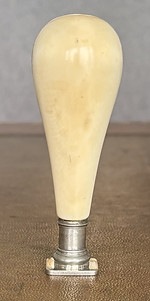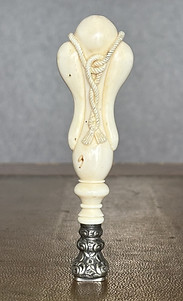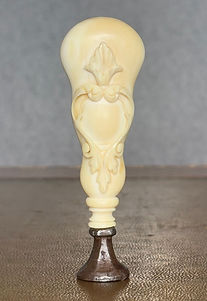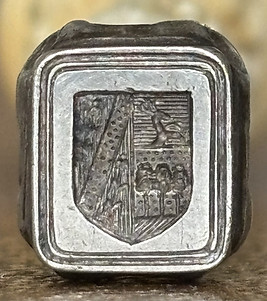The White Collection
Seal Stamps with White Handles in Bone, Horn, Ivory, and Mother-of-Pearl
Page 1 Page 2
This stamp was acquired in Germany. The handle is made of bone, which, while less prestigious than ivory, still lends the piece an elegant appearance and develops a pleasing patina over time. Notably, the eagles engraved on the shield and crest stand out. Their wings are extended straight, as if gliding, an uncommon depiction, as eagle wings are typically shown spread wide or raised.



In many cases, it is not possible to determine the owner of an antique wax seal stamp. In this instance, the only connection I found to this coat of arms is René du Puy. He was serving as abbot of Cormery from 1508 to 1519. The link between this stamp and René du Puy comes from the same coat of arms appearing on his tomb in the Abbaye of Cormery, located in the French department of Indre-et-Loire. However, the stamp features a marquis’s crown, which suggests it may not have belonged to René, as he was a member of the clergy. He was, however, the brother of Jacques du Puy, Seigneur de Nazelles. Additionally, an online search reveals another figure, Jacques du Puy-Montbrun, who was the 15th Marquis and Lord of Rochefort. The marquisate in this context appears to have been a courtesy title rather than an officially recognized noble rank. As a result, the precise origin of this stamp remains uncertain.






This nice ivory stamp belonged to Albert de Sonis (Born in 1854), who was married to Marie Pajot de Juvisy de Montferrand (Born in 1862). Albert was the son of General Louis-Gaston de Sonis, the 1st Count of Sonis. Louis-Gaston was a Count of the Roman Nobility, which was historically a title granted by the Pope, part of the Papal nobility system. Unlike hereditary noble titles from monarchies, a Roman title of Count could be either personal (for the recipient only) or hereditary. On their side, the Pajot family were the Marquis of Villiers, Lords of Saint-Aubin and Marcheval. The great-grandfather of Marie, Charles Pajot de Juvisy, born in 1769, married to Louise de Montferrand, creating the Pajot de Juvisy de Montferrand branch of the family.







This is a finely crafted antique wax seal stamp, notable for its ivory handle and silver base. The handle features a beautifully detailed carving of a knotted rope or cord. Based on the style of the carving, this piece could date from the late 18th to early 19th century. The arms are: Gules, a fess Azure charged with a crescent, between three mullets (2 in chief, 1 in base). The crescent is often used as a cadency mark for a second son in English heraldry but also appears in French and Italian arms symbolizing hope or a victorious second crusade.



Although I purchased this stamp without knowing its original owner, I’ve managed to narrow down the possibilities significantly. The lozenge shape of the seal indicates that it was used by an unmarried noblewoman. Based on the heraldic elements, it may have belonged to Anne or Anne-Charlotte de Crussol d'Uzès. They were the daughters of Jean-Charles, Prince of Soyons, 7th Duke of Uzès, 3rd Duke of Montausier, Marquis of Assier, Rambouillet and Pisani, Count of Crussol, and Lord of Lévis. The quartered coat of arms refers to a long lineage and alliances with the families de Gourdon de Genouillac, de Turenne, de Lévis, and the lordship of Assier (or Acier). The House of Crussol, is a surviving family of the French nobility, originating from Languedoc. The family was granted the title of Duke of Uzès in 1565 and elevated to the Peerage in 1572. It holds the distinction of being the oldest ducal title and the oldest peerage in France.







This is a double-ended wax seal stamp, an elegant and relatively uncommon type of noble seal. Such designs were particularly fashionable in the late 18th to early 19th century, especially in France, Italy, and parts of Germany. This configuration was most often used to display the heraldic arms of a married couple, one end bearing the husband’s arms, the other those of his wife’s family or, as in this example, a monogram.




This seal stamp with an elaborate ivory handle belonged to a member of the de Lastic family. The House of Lastic is one of the oldest families of Auvergne. Its patronymic name is Bompar. The Château de Lastic was situated on a hill between Saint-Flour and Brioude. This family produced distinguished figures throughout the centuries, among them Jean de Lastic, Grand Master of the Order of Saint John of Jerusalem. The lineage of this house has been documented since 1211. The arms of the lastic family are simple: Gules, a Fess Argent. But behind the shield on the engraving, we can see the cross of the Order of Knights of the Hospital of Saint John of Jerusalem, commonly known as the Knights Hospitaller. An eight-point Maltese Cross, also called the Cross of Saint John, representing a Hospitaller’s virtues: Reverence for the Church, piety, loyalty, courage, honor and glory, caring for the sick or poor, disregard for death, and honesty.







Charles Renaud de Lastic, chevalier de Saint Jean de Jérusalem, 1728
Antique seal stamp of a member of the de Lastic family,
from Auvergne in France
Jean de Lastic, Grand Maitre de Rhodes
19th century, Chateau de Versailles
The handle of this nice seal stamp is hand-carved in ivory, with Rococo-style ornamentation, floral motifs and volutes. This style was especially popular in the mid to late 18th century. Ivory handles of this quality were typically associated with noble or high bourgeois ownership, as ivory was expensive and symbolic of refinement. The coat of arms could be read as: "Arms: Per fess Argent and Azure, in chief a lion rampant, supported by a lion and a dog (?), the whole ensigned with a coronet of rank.



This refined antique seal stamp, with its delicately carved ivory handle crowned by a finely engraved comital coronet, bears the alliance arms of General Pierre-Louis Charles de Failly and Félicité de Frézals de Bourfaud. The de Failly family, originally from Lorraine, belonged to the military nobility of service, noted for their loyalty to France and the Empire. Pierre-Louis Charles de Failly (1810–1892) served as Minister of War under Napoleon. His wife, Félicité de Frézals de Bourfaud, came from an old noble family of Languedoc, whose roots reach back to the ancien régime. The Frézals de Bourfaud were landowners and magistrates, bearing arms of ancient extraction, emblematic of southern France’s hereditary nobility. The ivory handle mirrors the refinement of mid-19th-century aristocratic taste, making this stamp a small work of art.






General Pierre-Louis Charles de Failly
1810-1892

Wax seal engraved with the alliance arms of General Pierre-Louis Charles de Failly and Félicité de Frézals de Bourfaud.

Jean-Louis-Bernard de Frezals de Bourfaud
1708-1786
This nicely carved silver and ivory seal is engraved with the alliance arms of Louis Tardy de Montravel and Marie Amélie Vétillart du Ribert. The Tardy de Montravel family belonged to the ancient nobility of Vivarais (today’s Ardèche), long associated with local seigneurial and military service. Originally styled vicomtes de Montravel, the family derived its title from the fief of Montravel near Tournon-sur-Rhône, a vicomté held since at least the seventeenth century. Under the Bourbon Restoration, the family was recognized with the higher title of Comte de Montravel, reflecting both its loyalty to the monarchy and its service in the royal navy and administration. Among its most renowned members was Louis-Marie-François Tardy de Montravel (1811–1864), rear-admiral, explorer, and governor of New Caledonia and French Guiana. The bride’s family, the Vétillart du Ribert, originated in Maine and the Sarthe, where it rose through commerce, public office, and the professional elite during the eighteenth and nineteenth centuries. Their heraldic arms, often quartered or impaled with those of allied provincial nobles, signaled the family’s entry into the noblesse de robe and later the landed gentry. The marriage thus reflected a typical alliance of the age: the union of an older military aristocracy with an ascending bourgeois family of education and means. The seal was acquired together with the description, hand-written by their son Henri.





.jpg)
Antoine-Jean-Louis de Tardy de Montravel (1823 - 1909)

Handwritten note: Seal in silver and ivory of my mother, born Amelie V. de Ribert. Signature of Henri, youngest son of Antoine Louis and Marie Amelie. "Arms: de Tardy de Montravel and Vetillart du Ribert.".

Louise Vétillart du Ribert and her daughter Louise, the future comtesse de Lezay-Marnesia

Coat of arms of Antoine-Jean-Louis de Tardy, vicomte de Montravel
.jpg)
Jean François Damien Tardy de Montravel
(1744 - 1805)
This 19th-century wax seal stamp combines refined craftsmanship with elegant symbolism. Its handle, carved from ivory, is adorned with finely sculpted grape clusters and vine leaves - motifs often associated with abundance and Bacchic inspiration. The mount and matrix are in silver. The coat of arms engraved on the matrix depicts a stag above three trees, alongside what appear to be corns or sheaves, possibly evoking fertility, rural prosperity, and noble steadiness. A delicate object of both artistic and heraldic value.



This ivory seal stamp belonged to General Charles-Étienne-François Ruty (1774 - 1828), one of Napoleon’s foremost artillery officers. Educated at the artillery school of Châlons, he served from the Revolutionary campaigns through the Empire, earning distinction in Egypt, Spain, and at Friedland. Created Baron in 1808 and Count of the Empire in 1813, he embodied the meritocratic spirit of Napoleonic France. After 1814 he continued to serve under the restored Bourbon kings, receiving the Order of Saint-Louis and the Grand Officer cross of the Legion of Honor, and later sat as a Peer of France. His name is engraved on the Arc de Triomphe of Paris, a lasting tribute to his service. Married to Lucie Charlotte Lecocq, he was the father of Anatole de Ruty, also Count and Peer of France. A soldier, engineer, and statesman, he united discipline, intellect, and loyalty to France.





General Charles Etienne Francois Ruty

Arms of Charles Etienne Francois, Count Ruty

Name on the Arc the Triomphe in Paris
While my collection originates mostly from Europe, this old Siamese ivory seal is of particular interest. Both because its engraving echoes European heraldic composition and because of the significance of its symbols. In European terminology, the arms could be described as: “Tierced per pall: 1. A high ceremonial hat; 2. A chakra; 3. A cannon”. The high ceremonial hat (พระมาลาเส้าสูง) was worn by Siamese royals, nobles and high-ranking officials, especially from the Ayutthaya and early Rattanakosin periods. It is often associated with formal dress, processions, and court rank. The finest examples were adorned with gold and diamonds and trimmed with a bird-of-paradise feather. The chakra pattern (ลายจักร) is a potent emblem in Thai tradition, representing nobility, authority, and the power to govern. In classical Thai art, any form of the chakra or wheel is associated with Royalty and with the capacity to “set things in motion.” It is noteworthy that a white chakra was added to the Siamese flag in the early Rattanakosin period by King Rama I, reserved exclusively for royal use.




High ceremonial hat


Traditional Chakra pattern
Cannons of the Siamese army

The Thai flags
Page 1 Page 2
Gerry's Collection of Antique Seal Stamps.

